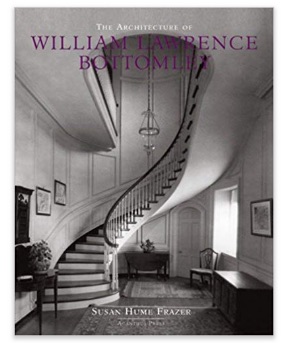In this Virginia History Blog, we review titles related to Virginia Modern Culture in architecture, art and education. “The Architecture of William Lawrence Bottomley” looks at his work in Virginia and New York. “Legacy: Walter Chrysler Jr.” describes the development and expansion of Norfolk’s Chrysler Museum of Art. “From VPI to State University” documents the achievements of university president T. Marshall Hahn in Virginia Tech’s growth in size and prestige.
Current releases related to Virginia history in other eras from Spring 2018 journals can be found in previous Virginia History Blogs at Colonial Virginia – Spring 2018, Revolutionary Virginia – Spring 2018, and Civil War Virginia – Spring 2018, and New South and Modern Virginia – Spring 2018.
The Architecture of William Lawrence Bottomley

Susan Hume Frazer wrote The Architecture of William Lawrence Bottomley in 2007. It is available from the Acanthus Press and online new and used.
Bottomley made his mark as a traditionalist residential architect during the 1920s and 1930s. Leveraging his privileged connections, Bottomly attended Columbia University and the Ecole Des Beaux-Arts, then pursued a career among prominent clients. His design skills lent expression to Georgian, Colonial and Mediterranean to Art Deco.
The range of his commissions spanned the small Davis family mausoleum to a sprawling country home in Redesdale, Henrico County. Bottomly designed several apartment buildings, and moved into a custom-designed Art Deco apartment in his River House in New York City. Bottomley’s daughter Eileen Loo married I. M. Pei there. The book illustrates the architecture with photos, supplemented with floor plans.
To buy “The Architecture of William Lawrence Bottomley” at Amazon, click here.
Legacy: Walter Chrysler Jr.

Peggy Earle wrote Legacy: Walter Chrysler Jr., and the Untold Story of Norfolk’s Chrysler Museum of Art in 2008. It is available from the University of Virginia Press and online new and used.
In the 1960s Walter Chrysler moved his personal art collection and museum from Provincetown, Massachusetts to Norfolk, his second wife’s hometown, transforming a small city museum into an “internationally esteemed showplace”. The college dropout, divorced and discharged from the Navy, eventually grew from an avid art collector to make it a vocation.
His “compulsive attention to detail and penchant for micromanaging practically every aspect of his businesses” led the philanthropist to bully. His obsession for filling in perceived gaps in his collection’s timeline led to a scandal following the discovery that many of the works in the Provincetown museum were not originals. After the move to Norfolk, the collection became fodder for contests among Chrysler, the museum board, city officials and family members.
To buy “Legacy Walter Chrysler Jr.” at Amazon, click here.
From VPI to State University

Warren H. Strother and Peter Wallenstein wrote From VPI to State University: President T. Marshall Hahn, Jr. and the Transformation of Virginia Tech, 1962-1974 in 2004. It is out of print, but available online new and used.
“Virginia Tech”, the Virginia Polytechnic Institute, began as a land grant college. It lagged behind in development of graduate education and federally supported research of the post-WWII academic revolution. Freeing it from political inertia and dysfunctional traditions required a transformative figure. It came about through the leadership of T. Marshall Hahn, Jr. during a presidency of twelve years.
As of 1960, only UVA was a full university. Virginia specialized its colleges by gender, by race and by function. VPI was limited to engineering and agriculture for men who were required to join ROTC. Hahn took over the VPI presidency in 1962. He had been head of its physics department, then University of Kansas dean of its School of Arts and Sciences. By 1966, women were admitted, graduate programs begun and Hahn had hired half of the faculty under a new merit system. On leaving in 1974, enrollments had nearly tripled, and doctorates increased five-fold.
To buy “From VPI to State University” at Amazon, click here.
Additional history related to Virginia during this time period can be found at the Table of Contents of TheVirginiaHistorian website on the page for Gilded Age, New South and 20th Century. Titles are organized by topics, political and economic Virginia, social history, gender, religious, African American, and Wars in Virginia 1750-1824.
General surveys of Virginia History can be found at Virginia History Surveys. Other Virginia history divided by topics and time periods can be found at the webpage Books and Reviews.
Note: Insights for these reviews include those available from articles in the Virginia Magazine of History and Biography, the William and Mary Quarterly, the Journal of the Civil War Era, the Journal of Southern History and the Journal of American History.

